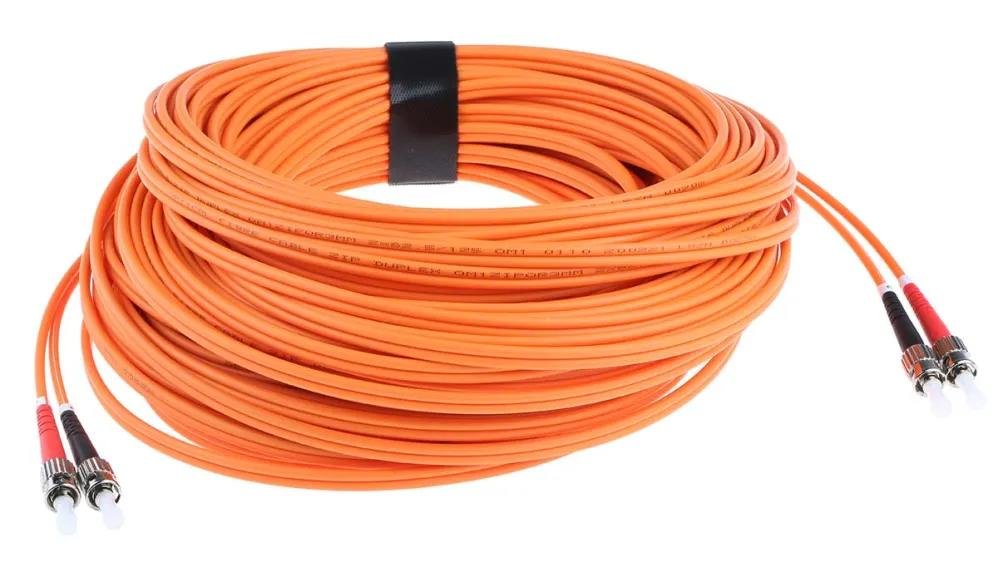ในโลกทุกวันนี้ที่เชื่อมต่อกันอย่างมากมาย อินเทอร์เน็ตความเร็วสูงและการส่งข้อมูลที่เชื่อถือได้นั้นเป็นสิ่งที่ไม่สามารถต่อรองได้ และ สายไฟเบอร์ออฟติกสีส้ม มีบทบาทสำคัญในการทำให้สิ่งนี้เป็นไปได้ โดยที่สีส้มอันเป็นเอกลักษณ์ของพวกมัน สายใยแก้วนำแสง ใช้กันอย่างแพร่หลายในระบบโทรคมนาคมและเครือข่ายเพื่อส่งข้อมูลด้วยความเร็วแสงโดยใช้สัญญาณแสง เทคโนโลยีใยแก้วนำแสงโทนสีส้มโดยทั่วไปจะบ่งบอกถึงไฟเบอร์แบบหลายโหมดที่ออกแบบมาสำหรับการใช้งานระยะสั้นที่มีแบนด์วิดท์สูง เช่น ศูนย์ข้อมูลและเครือข่ายองค์กร คู่มือสำหรับผู้เริ่มต้นนี้จะอธิบายเกี่ยวกับสิ่งที่ไฟเบอร์แบบหลายโหมด สายไฟเบอร์ออฟติกสีส้ม คือ วิธีการทำงาน ประโยชน์ ความท้าทาย และการประยุกต์ใช้ในโลกแห่งความเป็นจริง รวมถึงอนาคตในโลกแห่งการเชื่อมต่อที่เปลี่ยนแปลงอยู่ตลอดเวลา ไม่ว่าคุณจะเป็นผู้ที่ชื่นชอบเทคโนโลยีหรือมืออาชีพในอุตสาหกรรมโทรคมนาคม การทำความเข้าใจบทบาทของ สายไฟเบอร์ออฟติกสีส้ม จะทำให้เห็นถึงแกนหลักของเครือข่ายการสื่อสารสมัยใหม่ มาเจาะลึกนวัตกรรมที่มีชีวิตชีวานี้กัน เทคโนโลยีใยแก้วนำแสง!
สายไฟเบอร์ออพติกสีส้มคืออะไร?
การกำหนดสายเคเบิลใยแก้วนำแสงสีส้ม
หนึ่ง สายไฟเบอร์ออฟติกสีส้ม เป็นประเภทหนึ่งของ สายไฟเบอร์ออฟติก มักมีสีส้มเพื่อบ่งชี้การใช้งานเป็นไฟเบอร์หลายโหมดซึ่งออกแบบมาเพื่อส่งสัญญาณแสงหลายสัญญาณพร้อมกันในระยะทางสั้น เทคโนโลยีใยแก้วนำแสง, สายใยแก้วนำแสง ส่งข้อมูลเป็นพัลส์แสงผ่านแกนแก้วหรือพลาสติก ให้แบนด์วิดท์สูงและป้องกันสัญญาณรบกวนจากแม่เหล็กไฟฟ้า สีส้มทำหน้าที่เป็นตัวระบุมาตรฐานในอุตสาหกรรม ช่วยให้ช่างเทคนิคสามารถจดจำสายเคเบิลมัลติโหมดได้อย่างรวดเร็ว ซึ่งโดยทั่วไปใช้ในแอปพลิเคชัน เช่น เครือข่ายพื้นที่ท้องถิ่น (LAN) ศูนย์ข้อมูล และเครือข่ายมหาวิทยาลัยที่จำเป็นต้องมีการสื่อสารความเร็วสูงระยะสั้น การเข้ารหัสสีนี้ช่วยลดความยุ่งยากในการติดตั้งและบำรุงรักษาในสภาพแวดล้อมเครือข่ายที่ซับซ้อน

ทำไมต้องสีส้ม บทบาทของการเข้ารหัสสีในเทคโนโลยีไฟเบอร์ออปติก
ใน เทคโนโลยีใยแก้วนำแสง, การเข้ารหัสสี เป็นแนวทางปฏิบัติที่สำคัญสำหรับการระบุ ประเภทต่างๆของ สายใยแก้วนำแสงสีส้มของ สายไฟเบอร์ออฟติกสีส้ม เป็นมาตรฐานอุตสาหกรรมสำหรับไฟเบอร์มัลติโหมด โดยเฉพาะไฟเบอร์ที่มีขนาดแกน 62.5/125 ไมโครเมตร (OM1) หรือ 50/125 ไมโครเมตร (OM2, OM3, OM4) ตามที่กำหนดโดยมาตรฐาน เช่น TIA-598-ซีสีนี้ช่วยแยกแยะสายเคเบิลมัลติโหมดจากไฟเบอร์โหมดเดียว ซึ่งมักมีสีเหลืองและใช้สำหรับการส่งข้อมูลระยะไกล สีส้มช่วยให้ช่างเทคนิคสามารถระบุประเภทของสายเคเบิลได้อย่างรวดเร็วในระหว่างการติดตั้ง การแก้ไขปัญหา หรือการอัปเกรด ช่วยลดข้อผิดพลาดและเพิ่มประสิทธิภาพในการจัดการ สายใยแก้วนำแสง ภายในโครงสร้างพื้นฐานเครือข่าย
สายไฟเบอร์ออพติกสีส้มส่งข้อมูลอย่างไร
หนึ่ง สายไฟเบอร์ออฟติกสีส้ม ส่งข้อมูลโดยใช้สัญญาณแสง ซึ่งเป็นกระบวนการสำคัญ เทคโนโลยีใยแก้วนำแสงภายในสายเคเบิล แกนกลางที่ทำจากแก้วหรือพลาสติกจะส่งพัลส์แสงที่สร้างโดยแหล่งกำเนิดแสงเลเซอร์หรือ LED พัลส์เหล่านี้แสดงถึงข้อมูลดิจิทัลที่เดินทางผ่านแกนกลางโดยสะท้อนออกจากชั้นหุ้มโดยรอบ ในโหมดมัลติโหมด สายไฟเบอร์ออฟติกสีส้มเส้นทางแสงหลายเส้นทาง (หรือโหมด) เดินทางพร้อมกัน ช่วยให้สามารถส่งข้อมูลแบนด์วิดท์สูงในระยะทางสั้น ๆ โดยทั่วไปสูงสุด 2 กิโลเมตร ขึ้นอยู่กับข้อกำหนดของสายเคเบิล ซึ่งทำให้ สายไฟเบอร์ออฟติกสีส้ม เหมาะสำหรับแอปพลิเคชั่นที่ต้องการการสื่อสารที่รวดเร็วและเชื่อถือได้ภายในพื้นที่จำกัด เช่น อาคารหรือเครือข่ายภายในมหาวิทยาลัย
เทคโนโลยีเบื้องหลังสายเคเบิลใยแก้วนำแสงสีส้ม
โครงสร้างสายเคเบิลใยแก้วนำแสงสีส้ม
การ สายไฟเบอร์ออฟติกสีส้ม ถูกสร้างขึ้นด้วยหลายชั้นเพื่อให้มั่นใจถึงการส่งข้อมูลที่มีประสิทธิภาพและความทนทาน เทคโนโลยีใยแก้วนำแสงแกนของสายเคเบิล ซึ่งโดยทั่วไปจะมีเส้นผ่านศูนย์กลาง 50 หรือ 62.5 ไมโครเมตรสำหรับเส้นใยหลายโหมด จะทำหน้าที่ส่งสัญญาณแสง ล้อมรอบด้วยชั้นหุ้มที่สะท้อนแสงกลับเข้าไปในแกน ช่วยลดการสูญเสียสัญญาณ เคลือบป้องกันซึ่งมักเป็นสีส้ม ล้อมรอบชั้นหุ้มเพื่อป้องกันเส้นใยไม่ให้เสียหาย ตามด้วยชั้นเพิ่มเติม เช่น ส่วนเสริมความแข็งแรง (เช่น เส้นด้ายอะรามิด) และปลอกหุ้มด้านนอกเพื่อปกป้องสิ่งแวดล้อม สีส้มของสายเคเบิล สายไฟเบอร์ออฟติกสีส้ม ไม่เพียงแต่ระบุว่าเป็นไฟเบอร์หลายโหมดเท่านั้น แต่ยังเพิ่มการมองเห็นในระหว่างการติดตั้งและการบำรุงรักษาอีกด้วย ทำให้มั่นใจได้ว่า สายไฟเบอร์ออฟติก ได้รับการจัดการอย่างถูกต้อง.

สายไฟเบอร์ออพติกมัลติโหมดสีส้ม
การ สายไฟเบอร์ออฟติกสีส้ม โดยทั่วไปใช้ ไฟเบอร์มัลติโหมดซึ่งได้รับการออกแบบสำหรับการใช้งานระยะสั้นและแบนด์วิดท์สูง เทคโนโลยีใยแก้วนำแสงไฟเบอร์มัลติโหมดช่วยให้โหมดแสงหลายโหมดเดินทางผ่านแกนกลางพร้อมกัน ทำให้สายเคเบิลมีความจุมากขึ้นในการจัดการข้อมูลจำนวนมาก ซึ่งทำให้ สายไฟเบอร์ออฟติกสีส้ม เหมาะสำหรับสภาพแวดล้อมเช่นศูนย์ข้อมูลซึ่งการเชื่อมต่อความเร็วสูงระหว่างเซิร์ฟเวอร์ในระยะทางไม่กี่ร้อยเมตรเป็นเรื่องปกติ อย่างไรก็ตาม ไฟเบอร์มัลติโหมดมีการกระจายสัญญาณที่สูงกว่าเมื่อเทียบกับไฟเบอร์โหมดเดียว ทำให้มีระยะสัญญาณที่จำกัด ซึ่งเป็นสาเหตุ สายไฟเบอร์ออฟติกสีส้ม ส่วนใหญ่จะใช้สำหรับระยะทางสั้น ๆ ใน เทคโนโลยีใยแก้วนำแสง.
ขั้วต่อและอุปกรณ์สำหรับสายเคเบิลใยแก้วนำแสงสีส้ม
เพื่อบูรณาการ สายไฟเบอร์ออฟติกสีส้ม เข้าสู่เครือข่าย จำเป็นต้องมีตัวเชื่อมต่อและอุปกรณ์เฉพาะ เทคโนโลยีใยแก้วนำแสง, มัลติโหมด สายใยแก้วนำแสง เหมือนกับ สายไฟเบอร์ออฟติกสีส้ม มักใช้ตัวเชื่อมต่อเช่น เอสซี (ตัวเชื่อมต่อสมาชิก) หรือ แอลซี (Lucent Connector) ซึ่งเข้ากันได้กับไฟเบอร์แบบมัลติโหมด ขั้วต่อเหล่านี้จะเชื่อมต่อ สายไฟเบอร์ออฟติกสีส้ม ไปจนถึงอุปกรณ์เครือข่าย เช่น สวิตช์ เราเตอร์ หรือเครื่องรับส่งสัญญาณ ซึ่งแปลงสัญญาณแสงเป็นสัญญาณไฟฟ้าเพื่อให้อุปกรณ์ประมวลผล สีส้มช่วยให้ช่างเทคนิคมั่นใจได้ว่าพวกเขากำลังใช้สายเคเบิลและขั้วต่อมัลติโหมดที่ถูกต้อง ทำให้การตั้งค่าและการบำรุงรักษาเป็นไปอย่างราบรื่น สายใยแก้วนำแสง อยู่ในเครือข่าย
ตารางเปรียบเทียบ: สายไฟเบอร์ออพติกสีส้มเทียบกับสายไฟเบอร์ประเภทอื่น
นี่คือตารางข้อความธรรมดาที่เปรียบเทียบ สายไฟเบอร์ออฟติกสีส้ม กับประเภทอื่น ๆ สายใยแก้วนำแสง:
| ประเภทสายเคเบิล | สี | ประเภทไฟเบอร์ | ขนาดแกน | ระยะทางสูงสุด | กรณีการใช้งานทั่วไป |
|---|---|---|---|---|---|
| ไฟเบอร์ออฟติกสีส้ม | ส้ม | มัลติโหมด | 50/125 หรือ 62.5/125 ไมโครเมตร | สูงสุด 2 กม. | ศูนย์ข้อมูล, LAN |
| ไฟเบอร์ออฟติกสีเหลือง | สีเหลือง | โหมดเดียว | 9/125 ไมโครเมตร | สูงสุด 100 กม. | โทรคมนาคมระยะไกล |
| อควาไฟเบอร์ออฟติก | อควา | มัลติโหมด (OM3/OM4) | 50/125 ไมโครเมตร | สูงสุดถึง 550M | ศูนย์ข้อมูลความเร็วสูง |
ตารางนี้เน้นย้ำถึงลักษณะเฉพาะตัวของ สายไฟเบอร์ออฟติกสีส้ม เมื่อเทียบกับคนอื่น สายใยแก้วนำแสงเน้นบทบาทในแอปพลิเคชันระยะสั้นและแบนด์วิดท์สูง
ข้อดีของสายไฟเบอร์ออฟติกสีส้ม
แบนด์วิดท์สูงสำหรับแอปพลิเคชันระยะทางสั้น
ประโยชน์หลักประการหนึ่งของ สายไฟเบอร์ออฟติกสีส้ม มีแบนด์วิดท์สูง จึงเหมาะสำหรับการใช้งานในระยะทางสั้น เทคโนโลยีใยแก้วนำแสง, มัลติโหมด สายใยแก้วนำแสง เหมือนกับ สายไฟเบอร์ออฟติกสีส้ม สามารถจัดการข้อมูลจำนวนมาก เช่น สตรีมวิดีโอความละเอียดสูงหรือการถ่ายโอนไฟล์ขนาดใหญ่ได้อย่างง่ายดาย ทำให้เหมาะอย่างยิ่งสำหรับสภาพแวดล้อม เช่น ศูนย์ข้อมูลหรือเครือข่ายองค์กร ที่เซิร์ฟเวอร์และอุปกรณ์ต้องสื่อสารกันอย่างรวดเร็วในระยะทางไม่กี่ร้อยเมตร ทำให้มั่นใจได้ว่าการถ่ายโอนข้อมูลจะรวดเร็วและมีประสิทธิภาพด้วย สายไฟเบอร์ออฟติกสีส้ม.
ระบุและติดตั้งง่าย
สีส้มของ สายไฟเบอร์ออฟติกสีส้ม ให้ข้อได้เปรียบในทางปฏิบัติที่สำคัญ: การระบุที่ง่าย ใน เทคโนโลยีใยแก้วนำแสงโทนสีส้มมาตรฐานช่วยให้ช่างเทคนิคสามารถจดจำโหมดหลายโหมดได้อย่างรวดเร็ว สายไฟเบอร์ออฟติกลดความเสี่ยงของข้อผิดพลาดระหว่างการติดตั้งหรือการบำรุงรักษา ซึ่งมีประโยชน์อย่างยิ่งในสภาพแวดล้อมเครือข่ายที่ซับซ้อนที่มีประเภทต่างๆ มากมาย สายใยแก้วนำแสงซึ่งการแยกแยะระหว่างไฟเบอร์โหมดหลายโหมดและโหมดเดียวเป็นสิ่งสำคัญ สายไฟเบอร์ออฟติกสีส้ม ทำให้กระบวนการง่ายขึ้น ประหยัดเวลา และเพิ่มประสิทธิภาพในการตั้งค่าเครือข่ายและการแก้ไขปัญหา
ภูมิคุ้มกันต่อการรบกวนทางแม่เหล็กไฟฟ้า
การ สายไฟเบอร์ออฟติกสีส้ม ให้ภูมิคุ้มกันต่อสัญญาณรบกวนแม่เหล็กไฟฟ้า (EMI) ซึ่งเป็นข้อได้เปรียบหลักใน เทคโนโลยีใยแก้วนำแสง. ต่างจากสายทองแดง ซึ่งอาจได้รับผลกระทบจากสัญญาณรบกวนทางไฟฟ้าจากอุปกรณ์หรือสายไฟฟ้าที่อยู่ใกล้เคียง สายใยแก้วนำแสง ส่งข้อมูลโดยใช้แสง ทำให้ไม่เกิด EMI ซึ่งช่วยให้มั่นใจได้ถึงประสิทธิภาพที่เชื่อถือได้ในสภาพแวดล้อมที่มีกิจกรรมไฟฟ้าสูง เช่น โรงงานอุตสาหกรรมหรือศูนย์ข้อมูลที่มีความหนาแน่นสูง สายไฟเบอร์ออฟติกสีส้ม สามารถรักษาการเชื่อมต่อที่เสถียรและความเร็วสูงได้โดยไม่หยุดชะงัก

ความท้าทายของสายเคเบิลใยแก้วนำแสงสีส้ม
ระยะทางจำกัดสำหรับการส่งข้อมูล
ความท้าทายที่สำคัญของ สายไฟเบอร์ออฟติกสีส้ม เป็นระยะทางการส่งสัญญาณที่จำกัดเนื่องจากการออกแบบแบบหลายโหมด เทคโนโลยีใยแก้วนำแสง, มัลติโหมด สายใยแก้วนำแสง เหมือนกับ สายไฟเบอร์ออฟติกสีส้ม ทนทุกข์ทรมานจาก การกระจายโมดอลซึ่งโหมดแสงหลายโหมดเดินทางผ่านแกนกลางกระจายออกไปตามระยะทาง ทำให้คุณภาพสัญญาณลดลง ส่งผลให้ระยะการทำงานมีจำกัดเหลือเพียงประมาณ 2 กิโลเมตร ทำให้ไม่เหมาะสำหรับการใช้งานระยะไกล เช่น โทรคมนาคมข้ามประเทศ ซึ่งโหมดเดียว สายใยแก้วนำแสง จะถูกเลือกแทน
ต้นทุนที่สูงกว่าเมื่อเทียบกับทางเลือกอื่นที่ใช้ทองแดง
ในขณะที่ สายไฟเบอร์ออฟติกสีส้ม ให้ประสิทธิภาพที่เหนือกว่า อาจมีราคาแพงกว่าทางเลือกที่เป็นทองแดง ทำให้เกิดความท้าทายสำหรับการใช้งานบางประเภท เทคโนโลยีใยแก้วนำแสง, ต้นทุนการผลิต สายใยแก้วนำแสงพร้อมกับความต้องการอุปกรณ์เฉพาะทาง เช่น เครื่องส่งสัญญาณออปติคอลและขั้วต่อ สามารถสร้าง สายไฟเบอร์ออฟติกสีส้ม ระบบนี้มีต้นทุนในการติดตั้งสูงกว่าเครือข่ายแบบทองแดงแบบดั้งเดิม ปัจจัยด้านต้นทุนนี้อาจทำให้องค์กรขนาดเล็กไม่กล้านำระบบนี้มาใช้ สายไฟเบอร์ออฟติกสีส้มถึงแม้จะมีข้อได้เปรียบในเรื่องความเร็วและความน่าเชื่อถือก็ตาม
ความอ่อนไหวต่อความเสียหายทางกายภาพ
การ สายไฟเบอร์ออฟติกสีส้ม มีความเสี่ยงต่อความเสียหายทางกายภาพซึ่งอาจขัดขวางการส่งข้อมูลได้ เทคโนโลยีใยแก้วนำแสง, สายใยแก้วนำแสง ทำด้วยแก้วหรือพลาสติก ทำให้เปราะบางกว่าสายทองแดง สายไฟเบอร์ออฟติกสีส้ม อาจได้รับความเสียหายจากการดัด เฉือน หรือตัด ซึ่งอาจทำให้เส้นใยภายในขาดและหยุดการสื่อสาร แม้ว่าสีส้มจะช่วยให้มองเห็นได้ชัดเจนเพื่อป้องกันความเสียหายจากอุบัติเหตุ แต่การจัดการอย่างระมัดระวังและแนวทางการติดตั้งที่ถูกต้องถือเป็นสิ่งสำคัญเพื่อรักษาความสมบูรณ์ของ สายไฟเบอร์ออฟติก อยู่ในเครือข่าย
การใช้งานสายเคเบิลใยแก้วนำแสง Orange ในโลกแห่งความเป็นจริง
ศูนย์ข้อมูลและเครือข่ายองค์กร
สายไฟเบอร์ออฟติกสีส้ม ถูกใช้กันอย่างแพร่หลายในศูนย์ข้อมูลและเครือข่ายองค์กรซึ่งการสื่อสารระยะสั้นความเร็วสูงเป็นสิ่งจำเป็น เทคโนโลยีใยแก้วนำแสง, มัลติโหมด สายไฟเบอร์ออฟติกสีส้ม เชื่อมต่อเซิร์ฟเวอร์ อุปกรณ์จัดเก็บข้อมูล และสวิตช์ภายในศูนย์ข้อมูล รองรับแอปพลิเคชันแบนด์วิดท์สูง เช่น คลาวด์คอมพิวติ้งและการประมวลผลข้อมูลขนาดใหญ่ สีส้มช่วยให้ช่างเทคนิคระบุและจัดการสิ่งเหล่านี้ได้ สายใยแก้วนำแสง ในสภาพแวดล้อมที่มีผู้คนพลุกพล่าน เพื่อให้แน่ใจว่าการถ่ายโอนข้อมูลมีประสิทธิภาพและเชื่อถือได้ผ่านโครงสร้างพื้นฐานของเครือข่าย
เครือข่ายวิทยาเขตและอาคาร
ในเครือข่ายวิทยาเขตและอาคาร สายไฟเบอร์ออฟติกสีส้ม ให้การเชื่อมต่อความเร็วสูงระหว่างสถานที่ต่างๆ ภายในพื้นที่จำกัด เทคโนโลยีใยแก้วนำแสง, มัลติโหมด สายไฟเบอร์ออฟติกสีส้ม อาจเชื่อมต่ออาคารหลายหลังในมหาวิทยาลัย รองรับแอปพลิเคชันต่างๆ เช่น การประชุมทางวิดีโอ การเรียนรู้แบบออนไลน์ และการแชร์ไฟล์ สีส้มช่วยให้ช่างเทคนิคสามารถแยกแยะอาคารต่างๆ ได้อย่างง่ายดาย สายไฟเบอร์ออฟติก ระหว่างการติดตั้งหรืออัปเกรด ทำให้เป็นตัวเลือกที่เหมาะสมสำหรับโซลูชันเครือข่ายทั่วทั้งมหาวิทยาลัย
ระบบอัตโนมัติและระบบควบคุมอุตสาหกรรม
สายไฟเบอร์ออฟติกสีส้ม ยังใช้ในระบบอัตโนมัติและระบบควบคุมอุตสาหกรรมซึ่งการสื่อสารที่เชื่อถือได้เป็นสิ่งสำคัญ เทคโนโลยีใยแก้วนำแสง, ภูมิคุ้มกันของ สายใยแก้วนำแสง การรบกวนทางแม่เหล็กไฟฟ้าทำให้เกิด สายไฟเบอร์ออฟติกสีส้ม เหมาะสำหรับโรงงานหรือโรงงานที่มีเครื่องจักรขนาดใหญ่ ซึ่งสัญญาณรบกวนทางไฟฟ้าอาจรบกวนสายทองแดงแบบเดิมได้ สีส้มช่วยระบุตำแหน่งได้ สายไฟเบอร์ออฟติก ในสภาพแวดล้อมอุตสาหกรรม รับรองการส่งข้อมูลที่มั่นคงเพื่อการตรวจสอบและควบคุมระบบอัตโนมัติแบบเรียลไทม์
บทสรุป: บทบาทสำคัญของสายเคเบิลใยแก้วนำแสงสีส้มในการเชื่อมต่อ
การ สายไฟเบอร์ออฟติกสีส้มด้วยสีสันที่โดดเด่นและการออกแบบแบบหลายโหมด ถือเป็นรากฐานสำคัญของเครือข่ายระยะสั้นความเร็วสูงในโลกดิจิทัลปัจจุบัน เทคโนโลยีใยแก้วนำแสง, นี้ สายไฟเบอร์ออฟติก มีแบนด์วิดท์สูง ระบุได้ง่าย และป้องกันการรบกวน ทำให้เป็นตัวเลือกที่เหมาะสำหรับศูนย์ข้อมูล เครือข่ายในมหาวิทยาลัย และการใช้งานในอุตสาหกรรม แม้ว่าจะมีความท้าทาย เช่น ระยะทางที่จำกัด ต้นทุนที่สูงขึ้น และความเสี่ยงต่อความเสียหาย แต่ข้อดีของ สายไฟเบอร์ออฟติกสีส้ม—ควบคู่ไปกับความก้าวหน้าอย่างต่อเนื่องใน เทคโนโลยีใยแก้วนำแสง—เพื่อให้แน่ใจว่ายังคงมีความเกี่ยวข้องในการเชื่อมต่อสมัยใหม่ ในขณะที่เรามุ่งหน้าสู่อนาคตของเมืองอัจฉริยะ IoT และเทคโนโลยีที่ยั่งยืน สายไฟเบอร์ออฟติกสีส้ม จะยังคงเป็นส่วนสำคัญและมีชีวิตชีวาของโครงสร้างพื้นฐานการสื่อสารระดับโลก โดยขับเคลื่อนเครือข่ายที่เชื่อมต่อเราเข้าด้วยกัน

